Freshwater shrimp serve two functions in an aquarium. First, the varied colors and patterns of the various species add a punch of brilliance to planted tanks.
Meanwhile, their scavenger nature provides much-needed assistance with cleaning and algae removal.

With close to 600 varieties to choose from, aquarists can find a freshwater shrimp to appeal to their individual sensibilities and skill level.
These crustaceans come in every size, from dwarf to standard, accommodating tank sizes that suit every home.
In this article
Freshwater Shrimp Groups

In general, freshwater shrimp get divided into six main groups based on their classification and difficulty.
- Neocaridina shrimp: The dwarf shrimp are some of the most popular out there. They’re also some of the easiest to care for, making great choices for beginners.
- Caridina shrimp: If you want more of a challenge, these are the shrimp for you. Their needs are more demanding, but there are hundreds of colors and patterns to choose from.
- Baubalti shrimp: While not the easiest shrimp to find, this species splits the difference between Neocaridina and Caridina in terms of care.
- Sulawesi shrimp: These shrimp hale from the Sulawesi lakes of Indonesia. You have plenty of colors to choose from, but their care is tricky for beginners.
- Amano shrimp: If you want shrimp large enough to admire from a distance, this is the species for you. These avid algae-eaters are popular with aquarists across the board.
- Ghost shrimp: Some pet stores rank this species as “feeders.” However, ghost shrimp make excellent dwarf shrimp additions to peaceful community tanks.
The Incredible Variety of Freshwater Shrimp

Aquarists have taken the original colors found in the wild and selectively created hundreds of variations. If you can dream of a color or pattern, it likely exists.
The greatest variety comes from the Neocaridina and Caridina species. This table provides just a FEW examples.
| Caridina | Neocaridina |
| Tangerine Tiger Shrimp | Cherry Shrimp |
| Racoon Tiger | Snowball Shrimp |
| Yellow King Kong Shrimp | Blue Jelly Shrimp |
| Aura Blue Shrimp | Blue Dream Shrimp |
| Blue Bolt Shrimp | Carbon Shrimp |
| Shadow Panda Shrimp | Orange Shrimp |
| Golden Bee Shrimp | Chocolate Shrimp |
| Pinto Shrimp | Snow White Shrimp |
| Babaulti Shrimp | Green Jade Shrimp |
While it’s tempting to create a rainbow of shrimp within your tank, be careful about mixing different Neocaridina varieties.
They have no problem cross-breeding, and instead of getting a new color variety, you’ll likely end up with a murky brown. (Not attractive)
Freshwater Shrimp for Aquarium

The Atylidae family contains 450 species. While a couple venture into brackish water, the majority of the family adheres to freshwater.
The more primitive species lay small numbers of eggs that get released into the plankton for further development.
Within this family, the Caridina genus contains the largest number of species at 290. Neocaridina trails behind at just 30 species. However, new variations continuously crop up through selective breeding for dramatic colors and patterns in both groups.
1. Amano Shrimp (Caridina multidentata)

- Other Common Names: Yamato shrimp, Japanese marsh shrimp, Japanese swamp shrimp, algae-eating shrimp
- Difficulty: easy
- Temperament: peaceful
- Diet: omnivore
- Tank Size: 10 gal (38 l)
Amano shrimp gained their name from the famous aquarium aquascaper, Takashi Amano. He popularized the species in the 1980s after noting their preference for algae diets.
Since then, aquarists like to include these shrimp as natural means for eradicating algae. At around 2 inches or 5 cm in length, Amanos reach the top of the dwarf shrimp scale.
Females outgrow males, with males adopting spotted patterns along their sides. You can find varieties with either reddish-brown or bluish-green spots.
While caring for Amano shrimp is relatively easy, breeding is another matter. These freshwater shrimp require brackish water for their eggs, and the larvae need saltwater for proper development. So unless you plan on keeping three tanks on hand, maybe just buy your Amanos.
2. Bee Shrimp (Caridina cantonensis)
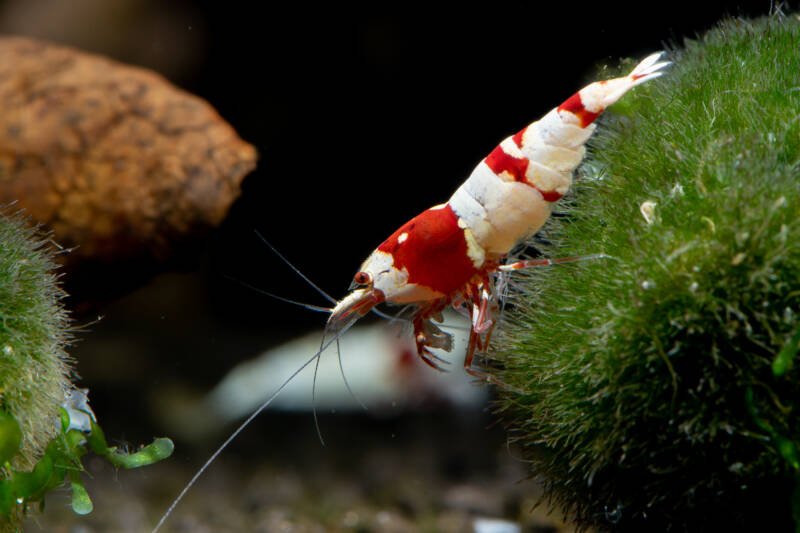
- Other Common Names: (none)
- Difficulty: moderate
- Temperament: peaceful
- Diet: omnivore
- Tank Size: 2 gal (7.5 l)
Bee shrimp sit on the tiny end of the dwarf shrimp scale. At around a length of one inch (2.5 cm), they don’t require much space, even for a group. There are also a dozen different color and pattern varieties to choose from.

If you want to keep an aquarium with bees, consider skipping fish tank mates. The tiny crustaceans are too much of a snack temptation.
Snails make great companions, though, and they won’t bother your shrimp (even if they’re larger than your bees).
Bee shrimp rank in the moderate zone for care due to their susceptibility to water changes. You need to keep the tank’s water quality high if you want them to remain healthy. And the smaller the tank size, the more difficult a job you’ll have.
3. Blue Bolt Shrimp (Caridina cf. cantonensis)

- Other Common Names: Taiwan bee shrimp
- Difficulty: easy
- Temperament: peaceful
- Diet: omnivore
- Tank Size: 10 gal (38 l)
The striking blue color on the dorsal side of this shrimp comes in a range of blue shades and transitions into a white belly. This color does not occur naturally and is the result of combining several Taiwan bee color variations.
The blue bolt adeptly cleans algae and needs rocky and plant surfaces on which algae grow.
They are sensitive to shifts in water conditions and like their water on the cooler side, preferring a range of 68 to 72°F (20 to 22°C).
These peaceful shrimp reach a length of 1.2 inches (3 cm) and hang out in groups. They are excellent additions to a community tank.
4. Tangerine Tiger Shrimp (Caridina serrata)

- Other Common Names: tupfel shrimp
- Difficulty: easy
- Temperament: peaceful
- Diet: omnivore
- Tank Size: 10 gal (38 l)
The tangerine tiger shrimp has a semi-transparent body with tints of yellow and orange and thick black stripes.
Found only in slow-moving rivers near Hong Kong, this species is listed as near threatened due to decline in its habitat.
Keep these shrimp in large groups to allow the highest comfort and activity levels. They will live peacefully with other gentle-tempered species in a community tank.
Tangerine tigers are safe to keep in planted tanks. They will actively help in maintaining them by grazing on any decaying leaves or stems. Keep the water temperature around 68 to 74°F (20 to 23°C) for their best health.
5. Tiger Shrimp (Caridina cf. cantonensis)
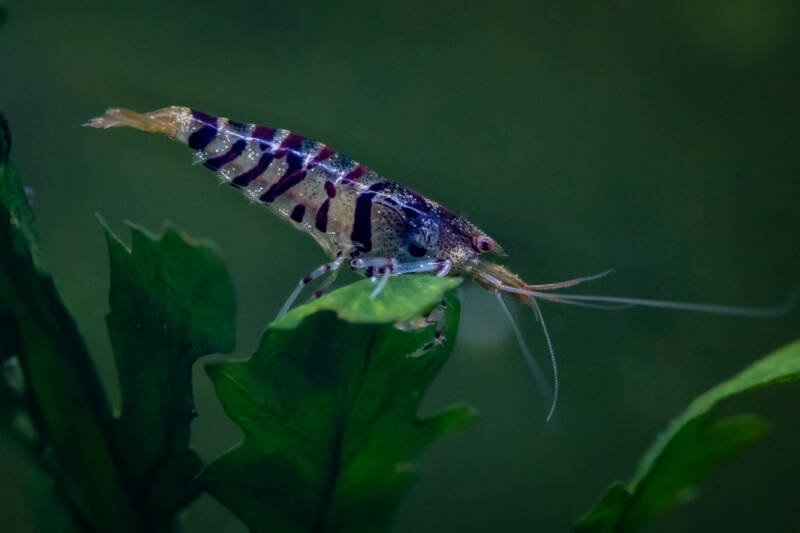
- Other Common Names: (none)
- Difficulty: easy
- Temperament: peaceful
- Diet: omnivore
- Tank Size: 10 gal (38 l)
With its transparent body, hint of yellow at the head and tail, and dark black stripes along the body, the tiger shrimp is an eye-catching species.
Tiger shrimp are highly active and need sufficient tank space to swim and scavenge. They can be on the shy side, so have plenty of hiding spaces for them and house them with peaceful tank mates.
Keep impurities, such as ammonia and nitrates, to zero levels in the water and the tank lighting low.
While it can be challenging to differentiate male from female, this species is easier to breed in a home aquarium than others on this list.
6. Cherry Shrimp (Neocaridina davidi)
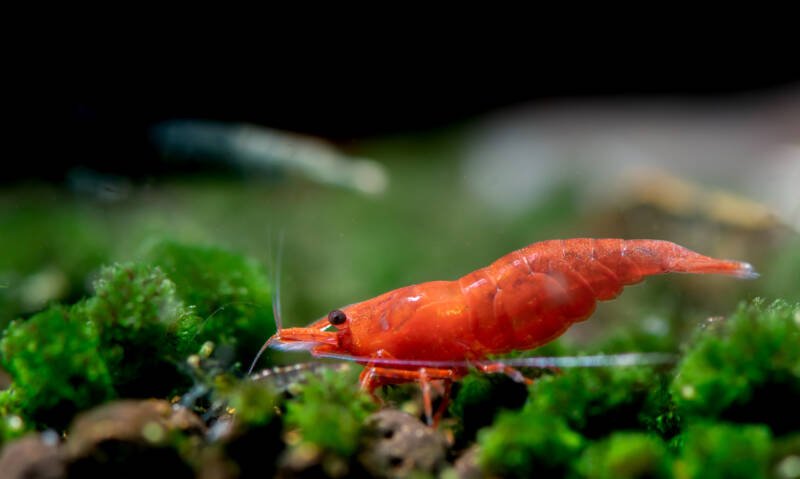
- Other Common Names: fire shrimp, sakura shrimp, rili shrimp
- Difficulty: easy
- Temperament: peaceful
- Diet: omnivore
- Tank Size: 5 gal (19 l)
Red cherry shrimp get their names based on the intensity of their color, from fire down to sakura (red to pink). However, cherry shrimp come in over 15 colors and patterns.
They top out around 1.5 inches (4 cm), making them ideal companions for other dwarf shrimp.
Cherry shrimp descend from the wild dwarf shrimp (Neocaridina denticulata sinensis), which DOESN’T come in red color. Aquarists selectively bred for the red mutation and other vibrant color variations.
Cherry shrimp are quite prolific. So while a small group might tolerate a smaller tank, they can quickly outgrow the tiny environment.
Make sure you select an appropriate aquarium for the numbers you plan to keep. Either that or make sure you separate your males and females!
7. Chocolate Shrimp (Neocaridina davidi)

- Other Common Names: sakura chocolate shrimp, cherry chocolate shrimp, fire chocolate shrimp
- Difficulty: easy
- Temperament: peaceful
- Diet: omnivore
- Tank Size: 5 gal (19 l)
The chocolate shrimp grows a bit larger than other species on this list but still is a reasonable 1.6 inches (4 cm) in size. Its rich chocolate color is a result of generations of selective breeding, and they come in three grades.
Chocolate shrimp are quite hardy and adaptable. They are hard working members of a tank cleanup crew
These shrimp are so easy going, you can place them with other peaceful shrimp species, fish, and even some snails in a community tank.
They are easy to breed in a home aquarium, but it can be difficult to tell if your females are carrying eggs due to their dark color.
8. Blue/Yellow Rili (Neocaridina davidi)

- Other Common Names: blue rili shrimp, yellow rili Shrimp, red rili shrimp
- Difficulty: easy to moderate
- Temperament: peaceful
- Diet: omnivore
- Tank Size: 10 gal (38 l)
Rili shrimp have semi-transparent bodies with bright splashes of color on the head and tail portions. They come in several color variations, including blue, red, and yellow.
Rili shrimp are durable scavengers that will prove their worth as a part of your tank cleanup crew. Keep them in a group of at least eight for optimum social behavior and high activity levels.
You can keep this species in a nano tank as small as two gallons, but a larger tank will better serve for a colony. Bigger tanks also allow for a more stable, mature environment suitable for your shrimp.
9. Vampire Shrimp (Atya gabonensis)
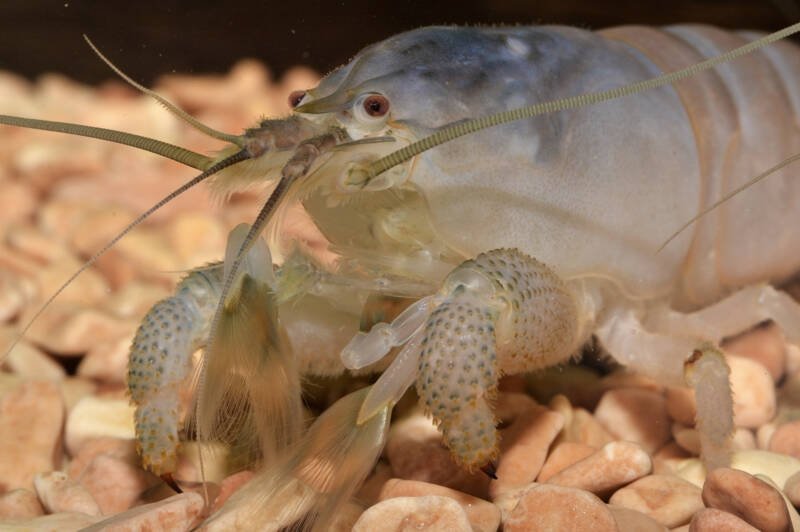
- Other Common Names: viper shrimp, African filter-feeder shrimp, African fan-feeding shrimp
- Difficulty: moderate
- Temperament: peaceful
- Diet: omnivore
- Tank Size: 20 gal (76 l)
No, you’re not getting a blood-drinking shrimp. Vampire shrimp get their name from the red cast to their eyes on a pale carapace.
They have the same fan-like mitts as bamboos, but the fans stay contained within the claws. People often mistake them for crayfish.
Where bamboo shrimp tend to hold their filter mitts out in the current for passive collection, vampires take a more active approach. They move their fans in upward and downward motions to trap food particles, making for exciting aquarium watching.
Despite the creepy name, vampires are friendly freshwater shrimp. However, they’re not the bravest crustaceans out there for all their bulk. You need to provide them with plenty of hiding places for when they’re feeling skittish and shy.
10. Babaulti Shrimp (Caridina babaulti)

- Other Common Names: (none)
- Difficulty: easy
- Temperament: peaceful
- Diet: omnivore
- Tank Size: 10 gal (38 l)
Despite the relative ease of their care, aquarists tend to overlook babaulti shrimp. Compared to other Caridina species, these freshwater shrimp are more tolerant of changes, making them ideal for beginners.
Babaultis come in a range of colors, including reds, yellows, greens, and browns. If you’re interested, there are also striped variations available.

Babaulti shrimp CAN interbreed with other Caridina species, so only keep them with Neocaridina species (unless you want hybrids).
Like other freshwater shrimp, babaultis are omnivores. However, these little crustaceans enjoy a “healthy” mix of decaying plant matter in their diet.
So if you have a beautiful planted tank, they’ll keep your aquarium looking its best.
11. Ghost Shrimp (Palaemonetes paludosus)

- Other Common Names: glass shrimp, grass shrimp
- Difficulty: easy
- Temperament: peaceful
- Diet: omnivore
- Tank Size: 5 gal (19 l)
Poor ghost shrimp get relegated to feeder shrimp status a lot of the time, but they’re gaining in popularity as aquarium-dwellers in their own right.
Their transparent body evolved as a defense against predators over several millennia.
These tiny dwarf shrimp fit nicely in any nano aquarium!
However, if you plan to breed ghosts, make sure to increase your tank size to accommodate the extra residents. You don’t want to create a poor water environment from excess waste.
Ghost shrimp are peaceful little crustaceans that do well in community tanks. Make sure you choose their tank mates well, though. They don’t get used as feeder shrimp for no reason, and you want your shrimp as friends, not food.
12. Pinto Shrimp (Caridina cf. cantonensis)
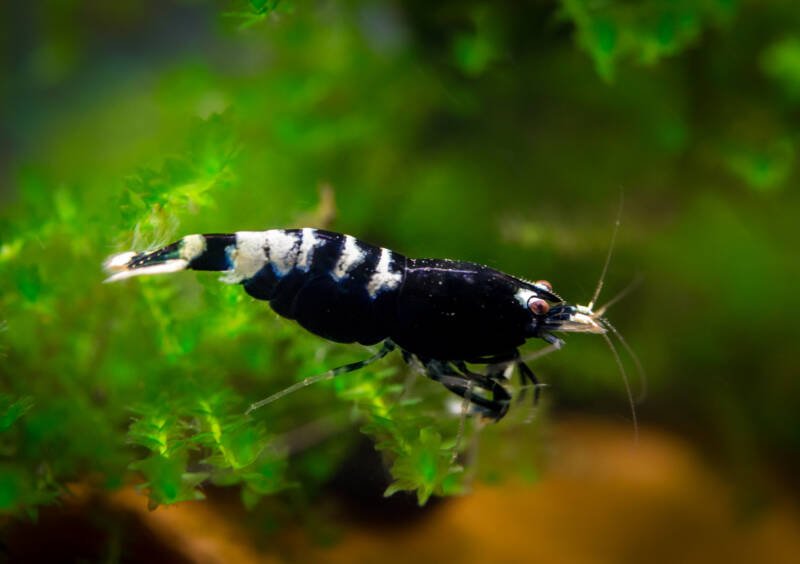
- Other Common Names: red zebra pinto, red pinto shrimp, black pinto shrimp
- Difficulty: moderate
- Temperament: peaceful
- Diet: omnivore
- Tank Size: 10 gal (38 l)
Pinto shrimp are another Taiwan bee variation. They come in two color variations: red and black. Contrasting white color can be either striped or spotted, giving them their common names.

The shrimp are small, reaching between one and 1.2 inches (2.5 to 3 cm), and do best in a well-planted, mature aquarium with a sandy substrate.
Pinto shrimp are active and will enliven a tank during daylight hours. They are also disarmingly speedy swimmers, capable of traversing the tank quickly.
The peaceful nature of this species makes them a must-have in a community tank with similarly tempered fish.
13. Snowball (Neocaridina zhangiajiensis)
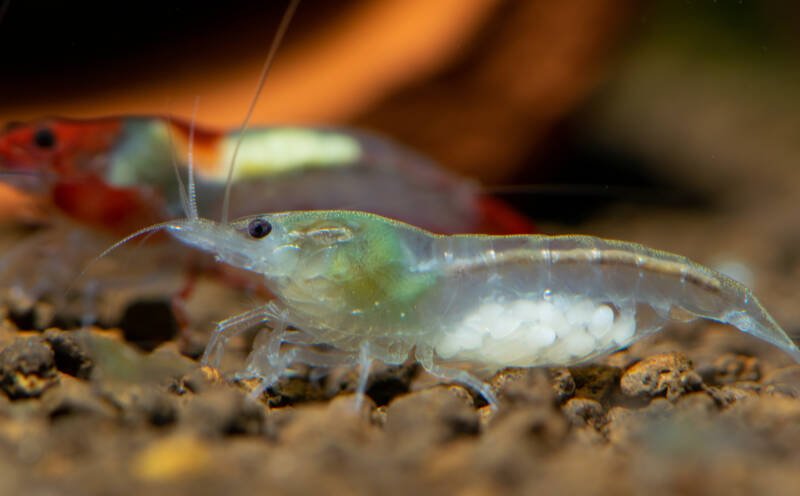
- Other Common Names: white pearl shrimp
- Difficulty: easy
- Temperament: peaceful
- Diet: omnivore
- Tank Size: 10 gal (38 l)
With their gorgeous crystalline white, semi-transparent bodies, snowball shrimp are a standout addition to a home aquarium. Interestingly, when the females are berried, their tiny eggs are a vibrant white and resemble snowballs.
This selectively bred species is incredibly hardy, peaceful, and a ready breeder. Keep them in a mixed group of at least 10 for their optimum comfort and best chances of breeding success.
Do not pair them with other Neocaridina species to prevent hybridization and offspring lacking white coloration. Snowball shrimp are an excellent choice for beginners as they tolerate wide water temperature and pH ranges and even the occasional parameter fluctuation.
14. Yellow King Kong (Caridina cf. cantonensis)
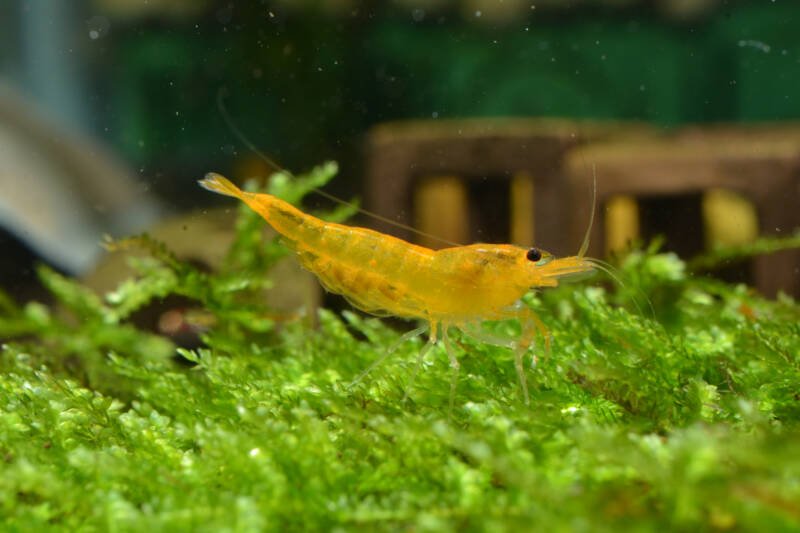
- Other Common Names: (none)
- Difficulty: easy
- Temperament: peaceful
- Diet: omnivore
- Tank Size: 10 gal (38 l)
Bringing a vibrant pop of yellow color, this shrimp species is hardy, requires minimal care, and looks amazing whether they are grouped together or exploring on their own.
Their lovely color comes from breeding tangerine tiger and blue bolt shrimp. They breed readily in a home aquarium, producing mostly solid yellow offspring with the occasional blue bolt appearing among the young.
These shrimp are peaceful and easily adapt to a community tank. Their adult length maxes out at 1.2 inches (3 cm).
Feed your yellow king kong shrimp a varied diet two to three times weekly. Provide a mature tank with biofilm, vegetables, and commercial shrimp food.
15. Green Jade Shrimp (Neocaridina davidi)

- Other Common Names: (none)
- Difficulty: easy
- Temperament: peaceful
- Diet: omnivore
- Tank Size: 10 gal (38 l)
True to its name, the green jade shrimp is an incredible, solid jade color. This member of the Neocaridina family’s color is uniform among specimens, so you will not see faded or spotted variations.
While their lifespan is a short one year, they readily breed in an aquarium setting, giving you continuous color in your tank.
These shrimp love lots of plants and hiding spaces. They will be more active in this comfortable environment.
Take particular care to ensure there is no trace of copper in your aquarium water, as this will be fatal to your shrimp. Test your water regularly and avoid medications that contain copper.
16. Crystal Shrimp (Caridina logemanni)
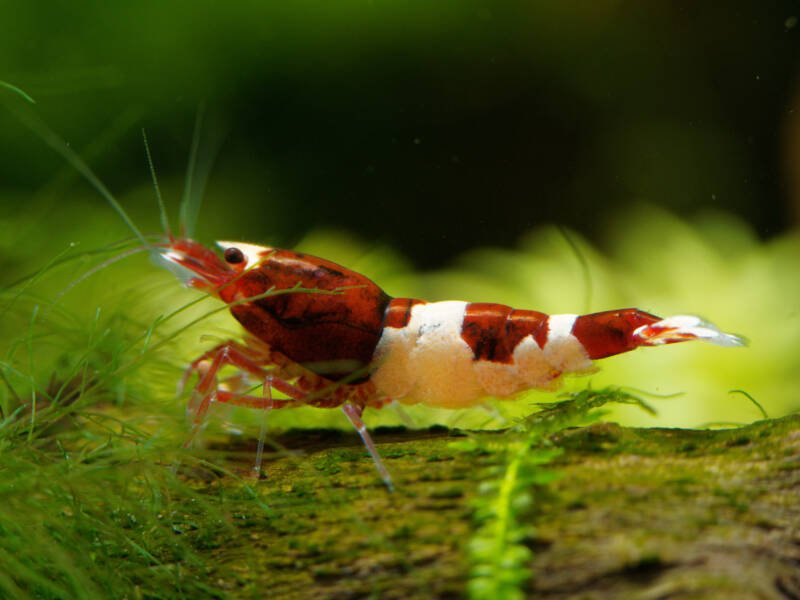
- Other Common Names: crystal red shrimp, red bee shrimp
- Difficulty: moderate
- Temperament: peaceful
- Diet: omnivore
- Tank Size: 10 gal (38 l)
Crystal shrimp are late-comers to the aquarium world. Japanese shrimp enthusiast, Hisayasu Suzuki, stumbled across the red color morph in one of his tanks in 1991. Through careful selective breeding and backcrosses, he was able to create the pure crystal shrimp strain.
Similar to bee shrimp, crystals have red and white stripes. You can find variations in the colors and patterns, though.

Depending on your palette, these shrimp can get quite expensive, so be careful when you start perusing the freshwater shrimp catalogue.
You need to stay on top of your water quality testing if you want to keep your crystal shrimp happy. This goes double if you plan to breed your crystals. Females only produce a few large eggs (unusual for shrimp), so you don’t get many chances for each breeding cycle.
17. Crystal Black/Black Bee Shrimp (Caridina cf. cantonensis)
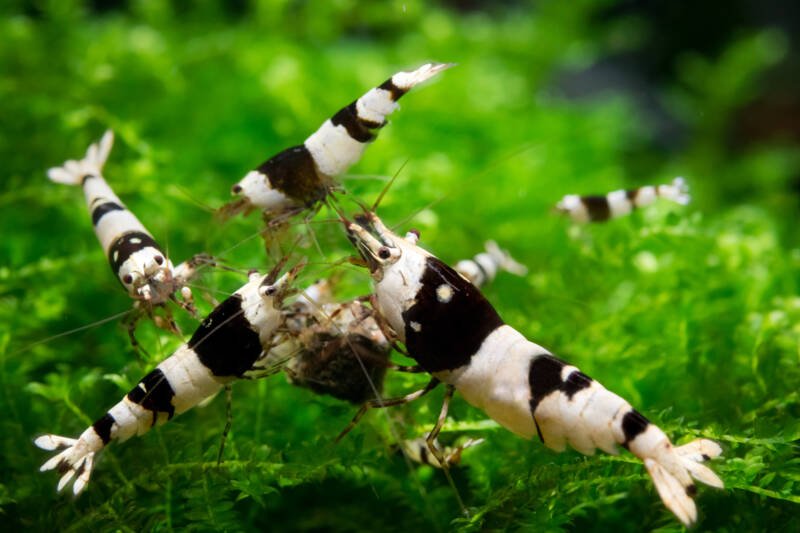
- Other Common Names: bee shrimp, black bee
- Difficulty: moderate
- Temperament: peaceful
- Diet: omnivore
- Tank Size: 10 gal (38 l)
The crystal black shrimp has advanced care requirements and should be kept by experienced aquarists. They prefer a narrow temperature range of 68 to 72°F (20 to 22°C) and thrive in a mature tank.
Routine testing is best to ensure no trace of copper is in the water. Be cautious with medications as well. Those containing even small amounts of copper can be fatal to your shrimp.
Give your crystal black shrimp plenty of space to explore. When paired with other peaceful species in a community tank, these shrimp will thrive.
Do not keep crystal black shrimp in a tank with breeding fish as they will consume the newly hatched fry.
18. Velvet Shrimp (Neocaridina davidi)
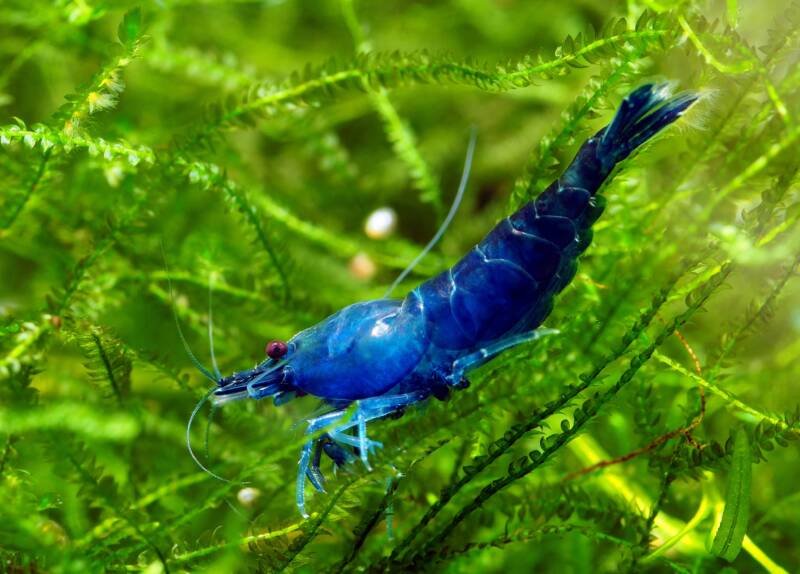
- Other Common Names: deep blue shrimp, blue dream shrimp, blue velvet shrimp, sapphire shrimp
- Difficulty: easy
- Temperament: peaceful
- Diet: omnivore
- Tank Size: 10 gal (38 l)
Not only does the velvet shrimp bring a deep blue color to your aquarium, but it is also incredibly hardy and easy to care for. This species is an excellent choice for a beginner aquarist interested in keeping shrimp.
This captive-bred specimen reaches an adult length of one to 1.5 inches (2.5 to 3.8 cm).
Dream blue shrimp are not as active during the daytime as some other species and tend to hide until night. Therefore, a heavily planted tank is best to allow them comfort, food sources, and hiding spaces.
They love to live in larger groups and are amazingly effective algae cleaners.
19. Shadow Panda (Caridina cf. cantonensis)
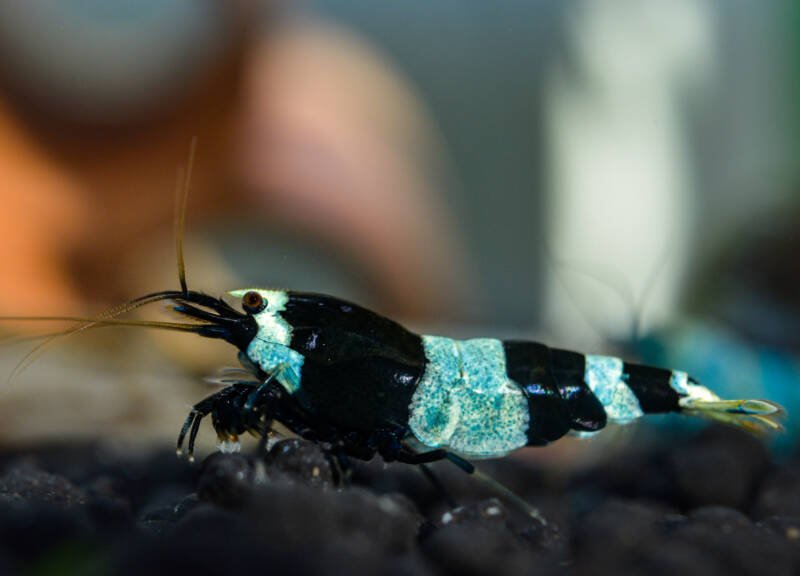
- Other Common Names: blue panda shrimp, black king kong panda, black panda shrimp
- Difficulty: difficult
- Temperament: peaceful
- Diet: omnivore
- Tank Size: 15 gal (57 l)
The shadow panda has sharply contrasting black and white patches, occasionally with a subtle hint of blue or green.
While these shrimp are peaceful, they are relentless in their feeding. Adding almond leaves to their water will help tint the water and resemble their natural habitat.
We have mentioned introducing species to a mature tank previously, but with the shadow panda, this is especially important. Cycle your tank for several weeks and test the water before introducing your shrimp.
This species does not breed as easily in an aquarium setting as do others on this list, making it slightly more expensive to purchase.
20. Aura Blue Shrimp (Caridina serrata)
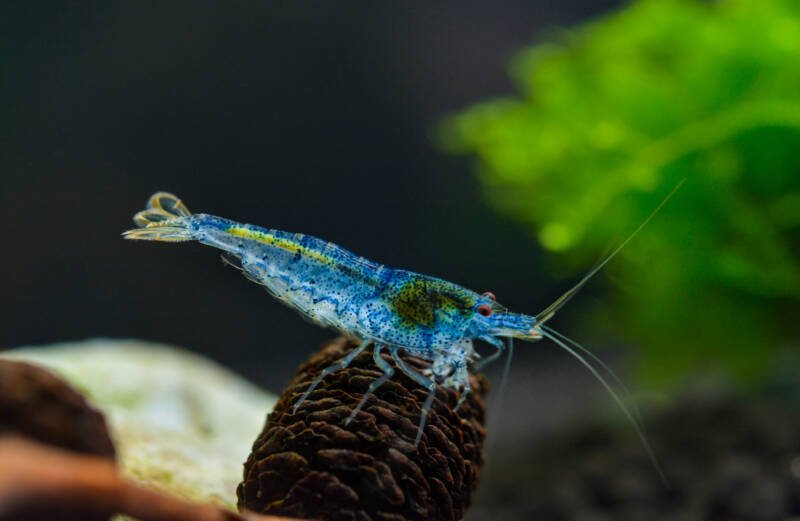
- Other Common Names: tupfel shrimp, blue tupfel
- Difficulty: moderate
- Temperament: peaceful
- Diet: omnivore
- Tank Size: 5 gal (19 l)
Aura blue shrimp are a tupfel shrimp variation featuring a range of gentle blue base colors. Darker blue spots or bands accent their semi-transparent body.
Adults will reach a length of around one to 1.4 inches (2.5 to 3.6 cm). They are ravenous algae eaters and great cleanup crew members.
They will breed in an aquarium setting, just ensure your filter system is buffered to protect the young shrimp.
This species can tolerate a wider water temperature range than many other dwarf shrimp species, anywhere from 64 to 78°F (17.8 to 25.6°C). They also do well in a wide pH range of 6.2 to 7.8.
21. Snow White (Caridina cf. Cantonensis)

- Other Common Names: white bee shrimp
- Difficulty: moderate
- Temperament: peaceful
- Diet: omnivore
- Tank Size: 10 gal (38 l)
Snow white shrimp have a milky, all-white coloration that can appear lightly speckled with beige spots. They are not currently widespread but are growing in popularity.
These shrimp have great temperaments. They are highly social and not territorial. If feasible, keep them in large groups.
They breed frequently, with each female producing 20 to 25 eggs in each batch. After hatching these eggs, they can be ready to breed again within a week.
The price for these shrimp can vary wildly depending on the grade. Aquarists should gain some experience in keeping shrimp before investing in a higher-grade snow white shrimp.
22. Bamboo Shrimp (Atyopsis moluccensis)

- Other Common Names: Asian filter-feeding shrimp, wood shrimp, singapore flower
- Difficulty: easy
- Temperament: peaceful
- Diet: omnivore
- Tank Size: 20 gal (76 l)
Bamboo shrimp get their name from the reddish-brown pattern of their carapace.
These non-aggressive freshwater shrimp have specialized fans that help them trap particles in the water. The web-like “mitts” require constant water circulation.
Bamboo shrimp are a healthy size, coming in around 4.5 inches (11 cm) in length.
Females are just a touch longer at 4.7 inches (11.9 cm), and they have slightly smaller front legs. Both of the sexes change color depending on their mood and tank environment.
Due to their peaceful nature, you need to be careful when selecting their tank mates. The larger size keeps them safe from most fish, but they can still suffer harassment from aggressive species such as bettas.
23. Cardinal Shrimp (Caridina dennerli)

- Other Common Names: sulawesi shrimp
- Difficulty: hard
- Temperament: peaceful
- Diet: omnivore
- Tank Size: 10 gal (38 l)
Cardinal shrimp hail from the Sulawesi lakes of Indonesia. Their brilliant crimson color and white feet make them appealing to aquarists, but their demanding water needs present challenges.
As lovely as they may appear, this species isn’t for beginners. Cardinals MUST be kept in single-species tanks.

They need harder water and a higher pH than most other freshwater shrimp, imitating the lakes they call home.
If you want them to survive, make sure your aquarium has a healthy biofilm before bringing them home.
The care for cardinal shrimp isn’t incredibly tricky (once the tank gets set up). Unhappily, they’re one of the most challenging species to KEEP alive. If you feel you’re up to the challenge, though, they make for vivid additions to an aquarium.
24. Pinokio Shrimp (Caridina gracilirostris)
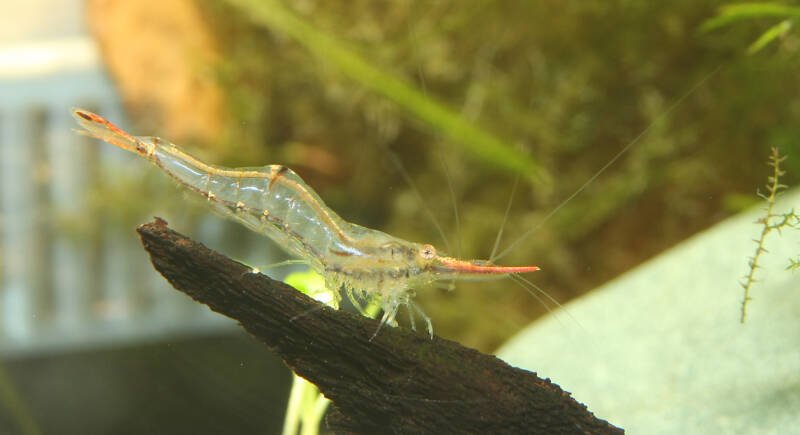
- Other Common Names: Rudolph shrimp, red-nosed shrimp, red skunk shrimp
- Difficulty: easy
- Temperament: peaceful
- Diet: omnivore
- Tank Size: 2 gal (7.5 l)
Pinokio (not the spelling from the fairy tale) shrimp aren’t as well-known or popular among aquarists. If you enjoy nano-aquariums, though, these dwarf shrimp should make your list.
They aren’t difficult to care for, and they have a unique appearance. Contrary to shrimp norms, male pinokios are larger and more colorful than females.
Both sexes have an elongated rostrum (the pointed part of the head). While delicate and capable of breaking, the rostrum CAN “regenerate” with the shrimp’s next molt.
Pinokios are active little shrimp. Through the scavenging process, they climb over plants throughout the tank. They’re also known to jump, so make sure you have a secure lid on your aquarium to prevent unwanted accidents.
25. Bumblebee Shrimp (Caridina breviata)
- Other Common Names: (none)
- Difficulty: moderate
- Temperament: peaceful
- Diet: omnivore
- Tank Size: 5 gal (19 l)
Contrary to popular belief, the bumblebee shrimp is NOT the same as the bee shrimp. True, you can find striped bee shrimp – which is what bumblebee shrimp are famous for – but they’re separate species.
Bumblebee shrimp are still dwarf shrimp, but they’re a little larger than their bee cousins.
However, they require the same fastidious water conditions. Make sure you avoid any ammonia or nitrites if you want to keep your bumblebees healthy.
Bumblebees do well in community tanks with cherry shrimp. The two WON’T interbreed, so you don’t have to worry about strange hybrids.
They make for great contrasting patterns, though. Best of all, they tolerate the same water conditions.
26. Whisker Shrimp (Macrobrachium lamarrei)
- Other Common Names: Indian whisker shrimp
- Difficulty: easy
- Temperament: semi-aggressive
- Diet: omnivore
- Tank Size: 10 gal (38 l)
People sometimes mistake whisker shrimp for ghost shrimp. Both are transparent, but whiskers are larger, lack the orange bands along the side, and have more prominent antennae.
You can house the two together, but whiskers WILL pick on the smaller ghosts. As a matter of fact, whiskers are bullies with A LOT of other freshwater shrimp. AND fish!
If you’re looking to keep these shrimp, consider housing them with snails or sturdier fish such as cichlids or goldfish.
Whisker shrimp make excellent scavengers. You’ll see them moving through the aquarium constantly, cleaning out the debris. Moss balls hold a favored place in their crustacean hearts, and you can watch them spend hours pulling food out of the fibers.
Tank Setup
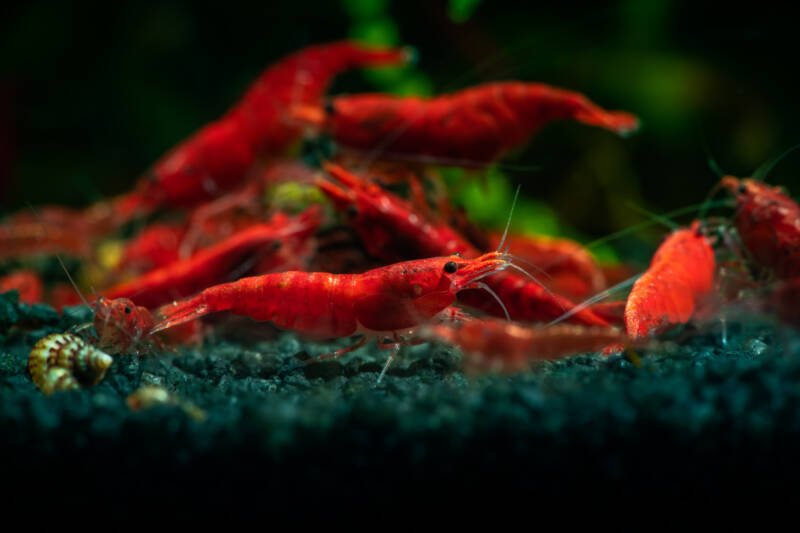
Setting up an aquarium for freshwater shrimp depends on the type of shrimp you plan to house. Each species comes from a different region, with varying water conditions.
Make sure you read up on your shrimps’ needs before you bring them home.
| Species | t° | pH | KH | GH | TDS | Nitrites | Ammonia | Nitrates |
| Amano Shrimp | 70-80°F 21-27°C | 6.0-7.0 | 2-5ppm | 6-8dH | 150-200 | 0ppm | 0ppm | <20ppm |
| Babaulti Shrimp | 65-85°F 18-29°C | 6.5-7.8 | 0-8ppm | 4-8dH | 130-300 | 0ppm | 0ppm | <20ppm |
| Bamboo Shrimp | 68-77°F 20-25°C | 6.5-7.5 | 2-7ppm | 4-8dH | 150-200 | 0ppm | 0ppm | <20ppm |
| Bee Shrimp | 68-78°F 20-26°C | 5.8-6.8 | 0-2ppm | 3-6dH | 130-300 | 0ppm | 0ppm | <20ppm |
| Bumblebee Shrimp | 65-85°F 18-29°C | 6.5-8.0 | 2-5ppm | 6-8dH | 150-200 | 0ppm | 0ppm | <20ppm |
| Cardinal Shrimp | 77-86°F 25-30°C | 7.5-8.5 | 2-8ppm | 4-8dH | 100-200 | 0ppm | 0ppm | <20ppm |
| Cherry Shrimp | 65-85°F 18-29°C | 6.5-8.0 | 2-5ppm | 6-8dH | 150-200 | 0ppm | 0ppm | <20ppm |
| Crystal Shrimp | 62-76°F 17-24°C | 5.8-7.5 | 0-2ppm | 4-6dH | 130-300 | 0ppm | 0ppm | <20ppm |
| Ghost Shrimp | 65-84°F 18-29°C | 6.5-8.4 | 2-5ppm | 6-8dH | 150-200 | 0ppm | 0ppm | <20ppm |
| Pinokio Shrimp | 75-80°F 24-27°C | 7.0-8.0 | 3-5ppm | 4-6dH | 200-500 | 0ppm | 0ppm | <20ppm |
| Vampire Shrimp | 75-84°F 24-29°C | 6.5-7.5 | 2-5ppm | 4-8dH | 120-350 | 0ppm | 0ppm | <20ppm |
| Whisker Shrimp | 65-80°F 18-27°C | 7.0-7.8 | 1-8ppm | 4-8dH | 200-500 | 0ppm | 0ppm | <20ppm |
All freshwater shrimp are sensitive to sudden water condition changes. When you clean your aquarium, make sure the water added matches the tank as closely as possible. You DON’T want to see shrimp actively swimming or trying to jump out of the tank due to stress!
You also need to be mindful of copper and other dissolved metals that may exist in your tap water. Copper is TOXIC to freshwater shrimp. A test kit will help you check for dissolved solids.
Dechlorinators and water conditioners are crucial for these little crustaceans.
The Cycled Shrimp Tank
Freshwater shrimp are omnivores. One of the most attractive features is their desire to feed on algae and the biofilm that coats tank surfaces.
This means your aquarium needs to HAVE a significant biofilm before you can introduce any shrimp species.
If your tank is brand-new, hold off on adding shrimp. Give your aquarium a chance to cycle and build up a nice layer of biofilm first. Otherwise, any shrimp you add will quickly starve and pass away. (Not what you were going for)
Shrimp like plants. Plants also provide plenty of surface area for biofilm to grow. Just don’t overdo the greenery as plants outcompete algae.
You want to strike a nice balance to provide a constant food source for your shrimp.
Tank Mates
Dwarf freshwater shrimp, in particular, need special consideration if you want to make them part of a community tank. Why?
Do you like eating shrimp? So do a lot of fish. Unless you plan to restock your shrimp on a routine basis, consider tank mates carefully.
Fish Companions
If you don’t plan to breed your shrimp (or you selected a species that requires brackish or seawater to complete their breeding cycle), you have a little more variety available for tank mates. While shrimp are delicious, shrimp fry is irresistible.
Even dwarf shrimp do fine with small fish tank mates. The standard rule applies: if the fish’s mouth is too small to hold a shrimp, you’re golden.
Good tankmates are:
Are you planning to challenge yourself with shrimp breeding? Then confine yourself to otocinclus catfish or plecostomus. These fish have suckers rather than toothy grins, so they won’t pose a risk to potential shrimp fry.
Non-Fish Options
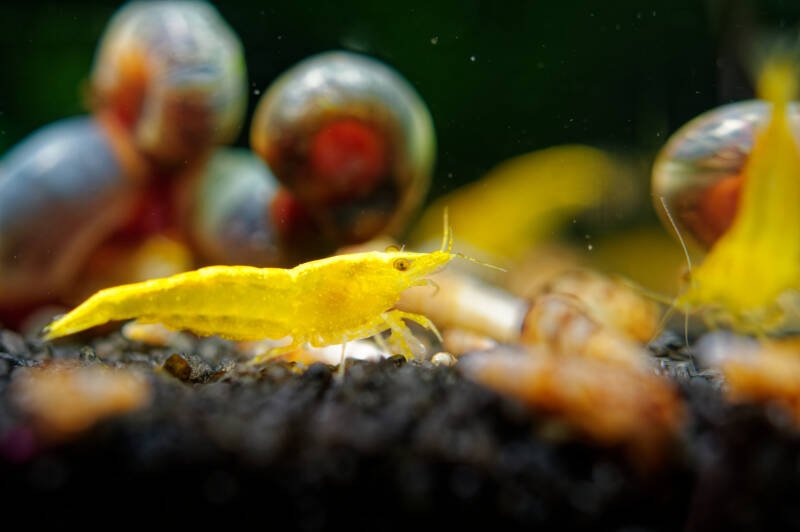
Invertebrate tanks make popular additions to any aquarist’s household. Best of all, you can combine your freshwater shrimp with peaceful snails who won’t pose harm to adults or fry.
Red ramshorns, spixi, and trumpet snails all coexist with freshwater shrimp beautifully.
Diseases
With tiny shrimp come great responsibilities. If you take on a dwarf shrimp species, invest in a quality magnifying glass. You’ll need the ability to check your mini crustaceans for signs of parasites or other signs of infection.
Some of the worst offenders hitchhike on the plants shrimp enjoy the most.
To prevent pests from invading, make sure you dip all-new plant acquisitions in a bleach solution. Then rinse them thoroughly in conditioned water before adding them to the tank.
- Planaria: Planaria are better known as flatworms. They attack and eat shrimp. You can add Planaria Traps or use an anti-planaria medication to eliminate them, but prevention works better.
- Hydra: Hydra come from the same family as jellyfish. As such, they sting shrimp with nematocysts. Anti-planaria medication might work, but you’re better off keeping them out in the first place.
- Scuds: If you’re trying to breed your shrimp, scuds represent the end of that project. These amphipods snatch up fry like popcorn. Unhappily, they also reproduce quickly. You’re stuck removing them manually.
- Dragonfly Nymphs: The larval stage of dragonflies find shrimp irresistible. They hunt and kill shrimp and fry alike, and they’re relentless. Once again, you have to remove nymphs manually.
Tiny Crustaceans, Huge Impact
Freshwater shrimp play essential roles in community aquariums. They clear out unwanted algae, scavenge leftover waste, and keep the nitrogen cycle running smoothly. If you can add a little color to those necessary functions, why not?
Have you embraced the freshwater shrimp craze?
Which are your favorite varieties? Let us know!